Taking children to the dentist can make you wonder if preventing and repairing dental issues is really worth all the hassle. As much joy as your kids can bring into your life, a trip to the dentist can quickly make you forget all of the positive experiences you’ve had with them thus far.

(Pixabay / bigbear)
While sedation dentistry isn’t necessarily a route you should consider for something as quick as a check-up, there are some circumstances and procedures where it might be a good option.
Why and when should I consider sedation dentistry for my child?
You might talk to your child’s dentist about sedation dentistry if your child has high anxiety or stress around doctors or dentists. Your child’s dentist might approach you about sedation dentistry if your child has a strong gag reflex or if he needs a lengthy procedure. Additionally, if your child is very young or has a disability that makes it difficult for him to sit still or relax enough for a procedure, you might consider sedation dentistry as an option.
What kinds of sedation dentistry are available?
There are two categories of sedation dentistry: conscious and unconscious. Dentistry where your child is completely unconscious should be done in a hospital under an anesthesiologist’s watchful care.
Conscious or semi-conscious sedation dentistry can be done in a dentist’s office without the inconvenience and added stress of going to a hospital. There are three main types of conscious sedation dentistry used by dentists today:
- Nitrous Oxide: Your child’s dentist might feel like nitrous oxide is the best option if it’s a relatively quick procedure or your child just needs a little bit of help staying calm. When administering nitrous oxide, the dentist will place a mask over your child’s face that has a mix of nitrous oxide and oxygen. This combination will keep your child awake and make him feel happy during the procedure. It usually takes about five minutes for the “laughing gas” to take effect, and when the procedure is over, the nitrous oxide will be switched off. Your child will then breathe in pure oxygen for about five minutes to remove any traces of nitrous oxide. Your child can eat before using nitrous oxide, but it should be a light meal like cereal, toast, or a piece of fruit.
- Oral Sedation: Oral sedation usually comes in the form of a pill or sugary drink that your child takes about 20 minutes before the procedure. It will keep her responsive but calm throughout the process. Since it is ingested, your child should not eat after midnight the night before the procedure in case she has any side effects.
- IV Sedation: Your child’s dentist may suggest IV sedation if the procedure is lengthy or if they foresee that they might need to adjust the sedative based on your child’s needs. The IV is inserted into your child’s hand, and the amount of sedative can be monitored and adjusted as necessary. Your child will be given special dietary instructions prior to the procedure to minimize the possibility of side effects.
What can I do to help my child on the day of the procedure?
Going to the dentist can be stressful for both you and your child, but there are some things that you can do to help him stay calm. The first thing is to stay calm yourself! Be completely honest as you fill out your child’s medical history so that the dentist can keep your child safe. You can also dress your child in loose-fitting, comfortable clothing, and allow him to bring a comfort object such as a stuffed animal or blanket. Stay nearby as the sedation is administered. Hold your child’s hand and talk softly to him to ease his fears. You know your child’s needs, so cater your actions to help him feel relaxed.
What are the usual after-effects?
Every child is different, so it’s difficult to give a one-size-fits-all answer to that question. You will be with your child as she comes out of sedation, and you might notice some behaviors that aren’t normal. She may be fussy, sleepy, angry, confused, or nauseous. These reactions are completely normal and should subside in a few hours. You should, however, make sure that your child takes it easy for the rest of the day. Even though the sedative wears off fairly quickly, your child’s mouth may still be numb, so you should watch carefully so that she doesn’t bite into her cheeks or lips unknowingly as she eats.
What are the risks?
As with any sedation or medical procedure, there are some risks, though they are very unlikely. One possible risk is that your child could experience an allergic reaction to the sedation. You should let your dentist know immediately if your child has severe vomiting, pain, bleeding, or a high fever.
These kinds of risks are very uncommon, but you should still discuss your concerns with your child’s dentist. Be sure to select a kids dentist in Utah that you feel completely comfortable with and can speak openly and honestly to. This kind of communication is vital to the success of both your child’s procedure and future oral health.
